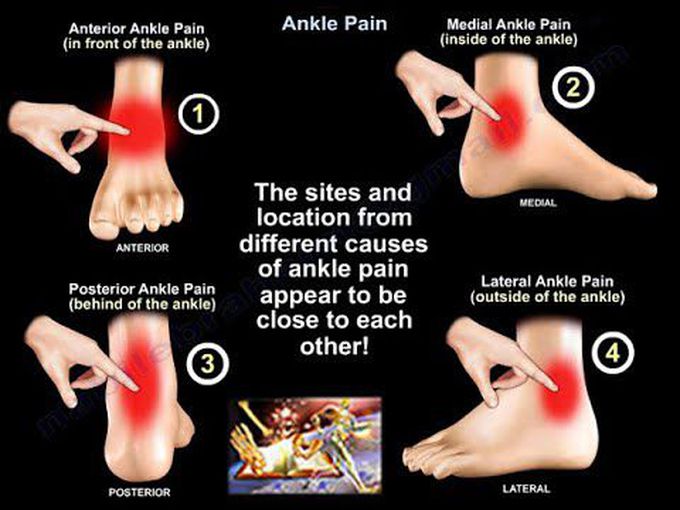


Ankle Pain - Everything You Need To Know - Dr. Nabil Ebraheim
Dr. Ebraheim’s educational animated video describes conditions associated with ankle pain. . What are the common causes of ankle pain? We are going to group all of the causes of ankle pain into 4 groups: Anterior ankle pain (in front of the ankle) Anterior lateral impingement: This is painful limitation of full range of motion of the ankle due to soft tissue thickening or tibial bony spur impinging on the talus, limiting dorsiflexion of the ankle. Arthritis of the ankle: Arthritis of the ankle can occur due to injury or due to inflammation. It can be diagnosed by examination or by an x-ray. Osteochondritis dissecans of the talus: A little chip fracture inside the ankle that causes pain, swelling, and stiffness. Medial ankle pain (inside of the ankle) Tarsal tunnel syndrome: Compression on the posterior tibial nerve produces symptoms of pain and numbness on the medial (inside) side of the ankle. When conservative treatment fails, surgical treatment of the tarsal tunnel release may be needed. Posterior tibial tendon tendonitis or rupture: Posterior tibial tendon problems can occur from overuse activities, from degeneration, or trauma. The posterior tibial tendon is one of the major supporting structures of the foot. The tendon helps to keep the arch of the foot in its normal position. When there is insufficiency or rupture of this tendon, the arch begins to sag, and a flatfoot deformity can occur associated with a tight Achilles tendon. The posterior tibial tendon rupture occurs in the hypovascular area, which is distal to the medial malleolus. The patient will have painful swelling on the posteriomedial aspect of the ankle. The patient will be unable to perform a single heel toe raise, too many toes sign, or flatfoot or fixed deformity of the hindfoot. Rupture of this tendon could be missed! Flexor hallucis longus tendonitis: Pain, swelling, and weakness posterior to the medial malleolus. Dorsiflexion of the big toe may be reduced when the ankle is placed in dorsiflexion. Triggering and pain along the tendon sheath may also occur with toe flexion. Posterior ankle pain (behind the ankle) Posterior ankle impingement (os trigonum): Os trigonum is a nonunited piece of accessory bone seen posterior to the talus. Tenderness in the posterior lateral aspect of the ankle posterior to the peroneal tendons, especially with passive plantarflexion of the ankle, may be seen in association with Flexor hallucis longus (FHL) tenosynovitis. Achilles tendonitis: Irritation and inflammation occurs due to overuse. Pain, swelling, and tears within the tendon. It is usually treated with therapy and eccentric exercises. It is rarely treated with surgery. Achilles tendon rupture: The Achilles tendon can become prone to rupture with age, lack of use, or by aggressive exercises. Rupture of the Achilles tendon is diagnosed by the Thompson test or by an MRI. Treatment may be conservative without surgery by doing early functional rehab. Or it can be treated with surgery by approximation of the torn ends of the tendon. The risk of surgery is infection and skin/wound complications. The risk of conservative treatment is a high rate of rerupture of the tendon. Lateral ankle pain (outside of the ankle) The cause of ankle pain on the outer side of the ankle may be a sprained ankle, but diagnosis of a sprained ankle may be the wrong diagnosis. There are other structures in this area that can mimic an ankle sprain, but it is not an ankle sprain. Ankle sprain: When the pain is anterior and around the fibula, it can be attributed to ligament sprain. Ankle sprain can be high ankle sprain (rare) or a low ankle sprain (common). Both types of ankle sprains are seen in this diaphragm. High ankle sprain: High ankle sprain is a syndesmotic injury and requires surgery. The high ankle sprain is a serious injury because it injures the ligament that connects the tibia to the fibula at the ankle joint. The diagnosis is usually done by the use of external rotation stress views or by CT scan. Low ankle sprain: A low ankle sprain is not a serious injury and it does not require surgery. Low ankle sprain is collateral ligament injury. With an ankle sprain, although the condition is painful, the patient will be able to walk. When there is a fracture of the ankle, the patient will be unable to walk due to severe pain. The treatment of ankle sprains will include immobilization, ice therapy, physical therapy, and rarely surgery. Diagnosis of a sprained ankle may be the wrong diagnosis. So, let us see what else can cause pain on the outside of the ankle. Peroneal tendon subluxation: Occurs due to rupture of the superior peroneal retinaculum. Rupture of the peroneus longus tendon: The os peroneum displaces proximally. Peroneal tendinitis Anterior process of the calcaneus fracture Lateral process of the talus fracture

